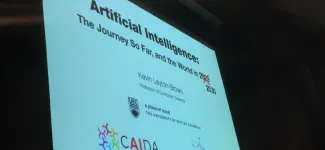Thinking (About) Computers
With Kevin Leyton-Brown
[image - Artificial Intelligence: The Journey So Far, and the World in 2029 2030]
Even one year can see dramatic changes in the development of, and our usage of, Artificial Intelligence. The struck-out year on the title of Kevin Leyton-Brown’s talk, 2029 to 2030, is evocative of the pace at which Artificial Intelligence (AI) is moving and evolving in the twenty-first century.
Kevin Leyton-Brown defined Artificial Intelligence as the study and development of computational processes that solve problems previously requiring human intelligence, and the “AI Paradox” comes about because once we integrate a technology into everyday life and become familiar with it, we no longer consider it Artificial Intelligence.
People are becoming increasingly fascinated by AI, with attendance at AI conferences increased six-fold in some cases from 2010-2018, and departments such as UBC’s seeing the demand for graduate studies in AI double over the past two years.
[Figure two: Kevin Leyton-Brown]
First developed in the 1950s, AI technology has advanced at an accelerated pace in recent years, along with computers generally. Kevin Leyton-Brown predicts that consumer desire will determine the future’s AI development more than anything else. This means that new technologies will develop for industries such as entertainment and education, as well as to ease household tasks and free up time.
When people talk about AI and the potential risks, popular imagination generally jumps to robots taking over the world and the fall of humanity. Movies as old as 2001: A Space Odyssey (1968) have sentient computers turning villainous and taking control. But in this talk we were brought back down to earth and advised that it is not the imaginary Terminator or RoboCop that we should be concerned about.
Instead, we should be paying more attention to the use of AI in military operations and weaponry. Drones, for example, are already commonly used in a number of military initiatives, for both spying and combative purposes. In a period of increasing political and international tensions the desire to incorporate more AI into military activities is certainly there. It is something that has perhaps not been as publicly noticed as it needs to be.
For more events and talks on Artificial Intelligence, check out CAIDA, UBC ICICS Centre for Artificial Intelligence Decision-making and Action.
Mairi Stirling Hill
Department of English Language and Literature, UBC
